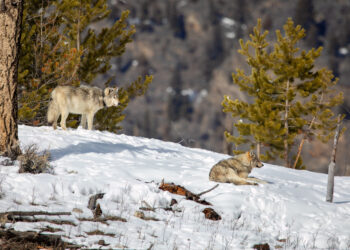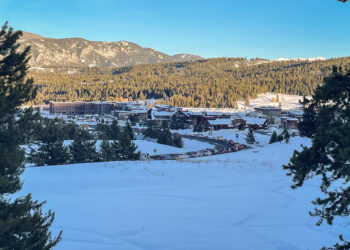Utah failed, Wyoming is trying. Montana is next?
By Benjamin Alva Polley EBS COLUMNIST
On Jan. 13, the Supreme Court emphatically rejected Utah’s attempt to seize federal lands. Utah’s lawsuit against the Bureau of Land Management sought to transfer 18.5 million acres of public lands to state control, arguing that the federal government could not indefinitely hold onto this land without designating it for specific uses such as a national forest or monument. Conservationists and environmentalists hailed this decision as a victory. However, the assault on public lands is far from over; it will persist throughout this administration across the West.
On the first day of its new session, the U.S. House of Representatives made a significant move: Altered its rules to facilitate federal land transfers to state governments. Republican leaders have long favored this power transfer to the states, and in light of Project 2025, the administration’s guiding manifesto, this is even more alarming.
Senator Mike Lee, a Republican from Utah, has long been a sworn enemy of public lands and is now the chair of the Energy and Natural Resources Committee and is helping to lead the charge in the massive land grab.
Currently, the federal government manages nearly 50% of the West’s landscape on behalf of the American people. Yet, many Republican-led states are pushing to take control of these lands to prioritize extractive industries and real estate development. These legal battles impose a significant financial burden on taxpayers, costing millions per state.
The amendment to the House rules means they are no longer required to account for the budgetary impacts of transferring land from the federal government to the states. Previously, they had to demonstrate the substantial fiscal implications of such transactions. Most of these land transfers result in significant financial losses for the federal government when the land is given away. This change will facilitate the sale of public lands to states, clearing the way for opportunistic exploitation. They will no longer have to consider the land’s worth to the American people.
Some may argue that the administration’s layoffs of federal employees bolster the case that the federal government lacks the resources to manage public lands effectively. However, this is a deliberate strategy by the current administration, which has slashed budgets and laid off thousands, only to claim that states would perform better in management. They are starting the fire and masquerading as saviors. The inevitable outcome will be the transfer of these lands to states, which, lacking the budget for responsible management, will be forced to sell them to the highest bidder—billionaires and corporations—leaving the American people with nothing.
Environmental groups view this maneuver as a tactic to sidestep federal environmental review for leasing these lands to extractive industries. BLM lands serve multiple purposes, all with equal footing, including providing space for wildlife and recreation and mining or logging. States may fail to recognize or preserve these vital uses, prioritizing a revenue stream over environmental stewardship. This power move on American public lands is a means to undermine the Endangered Species Act, which only applies to federal lands. Once these lands are handed over to states, habitat protections for endangered species will be critically weakened.
On Feb. 6, the Wyoming Senate narrowly voted for a resolution demanding that Congress transfer 30 million acres to the state. A celebrated 46% of Wyoming comprises federal land owned by the American public. Wyoming is following Utah’s reckless lead in advocating that drilling, mining and logging interests should have more favor than conservation on BLM lands. Advocates for this transfer even seek to strip Grand Teton National Park from the American people. Fortunately, Senate Joint Resolution 2 died in the Wyoming Senate on Wednesday, February 12.
This situation, originating in Utah, has ripple effects in Wyoming, Montana and Alaska. Alaska senators and its governor want to open the Arctic National Wildlife Refuge to energy dominance. According to Land Tawney, co-chair of American Hunter and Anglers, on Outdoor News Radio, “Energy independence and increasing energy development is good, but energy dominance means someone loses.” Biden denied the Ambler Road project in Alaska, but it will be back on the table with this administration. This road would jeopardize Indigenous lifeways and one of the largest caribou herds in Alaska and harm many rivers that fish and native people rely upon.
Montana lawmakers also irresponsibly support a dangerous resolution supporting Utah’s anti-public lands lawsuit. Many Montana legislators endorse LC 2912, a reckless resolution attempting to seize control of over 18.5 million acres of BLM land. Despite the U.S. Supreme Court’s dismissal of the case, the possibility of its reopening looms, posing a direct threat to Montana’s public lands.
LC 2912 escalates the misguided narrative, declaring that federal land ownership in Montana is “unconstitutional” and undermines the state’s sovereignty. This represents a direct assault on Montana’s public lands, which we depend on for hunting, fishing, hiking, and recreation. The BLM manages 8.1 million acres within Montana’s borders.
If Utah’s lawsuit succeeds, it could pave the way for privatizing millions of acres in Montana and the West, threatening cherished areas in Montana like the Missouri Breaks, Lee Metcalf Wilderness and the Pryor Mountain Wilderness. This fight is not just about land; it’s about the future of public resources and the rights of the American people.
This administration also aggressively pursues opening other National Monuments, such as Bear’s Ears, Chaco Canyon, and Grand Staircase.
“Anybody who hunts and fishes, this is a time to hold our elected officials accountable, and that means both at a congressional and administrative level,” Tawney said. “We should demand what we want…Public lands stay in public hands.”
Benjamin Alva Polley is a place-based storyteller. His stories have been published in Audubon, Esquire, Field & Stream, The Guardian, Outside, Popular Science, Sierra, and other publications on his website. He holds a master’s in Environmental Science and Natural Resource Journalism from the University of Montana. Follow him on Instagram.













